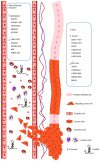Functions and mechanisms of long non-coding RNA in esophageal squamous cell carcinoma (Review)
- PMID: 40642605
- PMCID: PMC12242912
- DOI: 10.3892/ol.2025.15164
Functions and mechanisms of long non-coding RNA in esophageal squamous cell carcinoma (Review)
Abstract
Esophageal cancer (EC) is a highly prevalent and lethal malignancy of the digestive system, characterized by a complex pathogenesis involving multigene abnormalities and epigenetic regulation. Long non-coding RNAs (lncRNAs) are key regulatory elements in esophageal squamous cell carcinoma (ESCC). lncRNAs, defined as ncRNA molecules >200 nucleotides in length, modulate gene expression through diverse mechanisms, including epigenetic modification, competing endogenous RNA networks and RNA-protein interactions. lncRNAs participate in regulating key biological processes in ESCC, such as tumor cell proliferation, invasion, metastasis, apoptosis, drug resistance, radioresistance, stem cell properties and epithelial-mesenchymal transition. The present review summarizes the regulatory roles of lncRNAs in ESCC pathophysiology and their potential clinical application, emphasizing specific regulatory axes and mechanistic pathways implicated in esophageal carcinogenesis. Future studies should explore the molecular mechanisms of lncRNAs and their translational application to improve prognostic outcomes for patients with ESCC and identify novel therapeutic targets. These efforts may provide innovative strategies and directions for advancing precision oncology in ESCC management.
Keywords: esophageal squamous cell carcinoma; function; long non-coding RNA; mechanism; prognostic.
Copyright: © 2025 Lin et al.
Conflict of interest statement
The authors declare that they have no competing interests.
Figures


Similar articles
-
[Research progress on the regulation of ferroptosis by non-coding RNAs in esophageal squamous cell cancer].Sheng Li Xue Bao. 2025 Jun 25;77(3):563-572. doi: 10.13294/j.aps.2024.0078. Sheng Li Xue Bao. 2025. PMID: 40566721 Review. Chinese.
-
Natural products and long non-coding RNAs in prostate cancer: insights into etiology and treatment resistance.Naunyn Schmiedebergs Arch Pharmacol. 2025 Jun;398(6):6349-6368. doi: 10.1007/s00210-024-03736-x. Epub 2025 Jan 18. Naunyn Schmiedebergs Arch Pharmacol. 2025. PMID: 39825964 Free PMC article. Review.
-
Roles of lncRNAs in pancreatic ductal adenocarcinoma: Diagnosis, treatment, and the development of drug resistance.Hepatobiliary Pancreat Dis Int. 2023 Apr;22(2):128-139. doi: 10.1016/j.hbpd.2022.12.002. Epub 2022 Dec 14. Hepatobiliary Pancreat Dis Int. 2023. PMID: 36543619
-
Role of long non-coding RNAs in neurofibromatosis and Schwannomatosis: pathogenesis and therapeutic potential.Epigenomics. 2024 Dec-Dec;16(23-24):1453-1464. doi: 10.1080/17501911.2024.2430170. Epub 2024 Nov 27. Epigenomics. 2024. PMID: 39601046 Review.
-
Decoding the role of novel long noncoding RNAs lnc-SLC6A12-1:3 and lnc-SLC6A12-7:5 in regulating the expression of GAD1 and SLC6A12 in cholangiocarcinoma.Comput Biol Chem. 2025 Jun 20;119:108562. doi: 10.1016/j.compbiolchem.2025.108562. Online ahead of print. Comput Biol Chem. 2025. PMID: 40578094
References
Publication types
LinkOut - more resources
Full Text Sources
